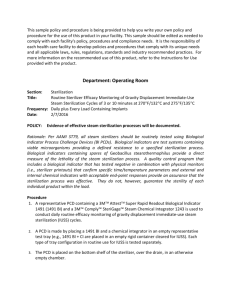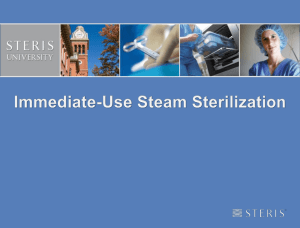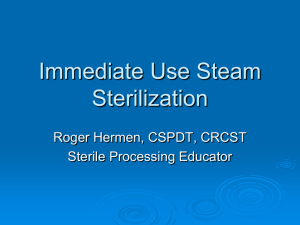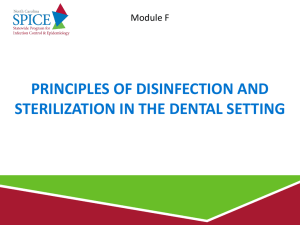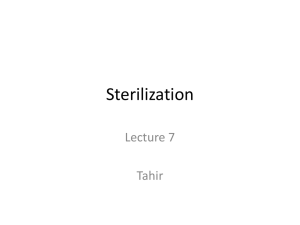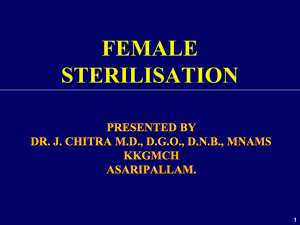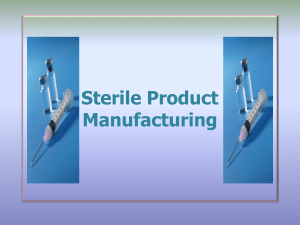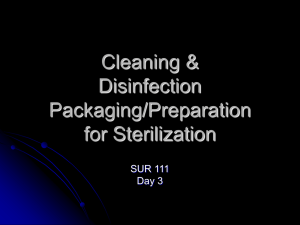Class_4_Sterilization
advertisement
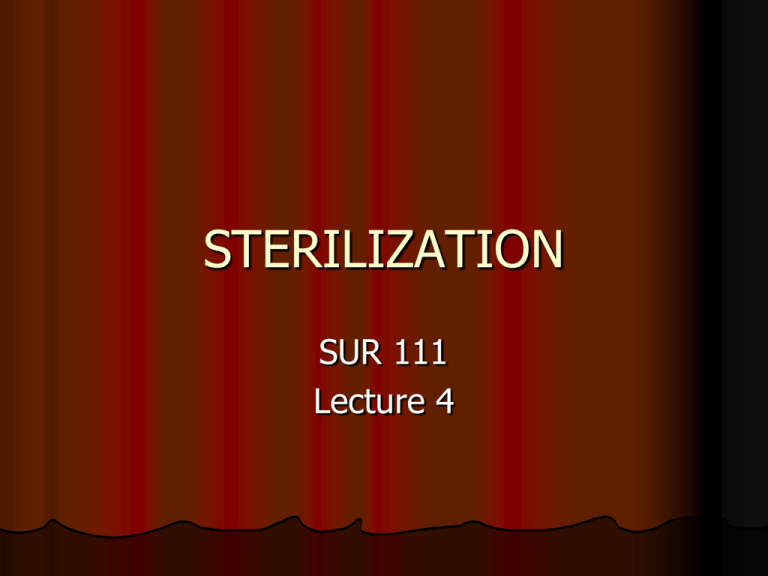
STERILIZATION SUR 111 Lecture 4 Today’s Topics Steam Sterilization Gas Sterilization Ionizing Radiation Monitoring Sterilization Event Related Sterility Environmental Services Sterilization Process of destroying all microorganisms including bacteria with spores on inanimate objects or surfaces Monitoring must be done through mechanical, chemical and biological methods Steam Sterilization (Autoclave) This agent of sterilization uses moist heat in the form of heat under pressure to achieve sterilization Microorganisms are destroyed by denaturation and coagulation of the enzyme protein system within the cell of the microorganism Saturated steam (most water vapor possible) is heated to greater than 250˚ F or 121˚ C Steam at atmospheric pressure only has a temperature of 212˚ F or 100˚ C In the autoclave, this pressure is increased to 15 to 17 pounds per square inch and increases the temperature to the required degree Steam Sterilizers Two Types: 1. Gravity Passive removal of air from the chamber Four cycles 2. Prevacuum vacuum-pump removes the air Six cycles Steam Sterilization “Autoclave” 1. Gravity Sterilizer Water is heated and converted to steam Steam submitted to increasing pressure which increases the temperature Steam drives heavier air out an escape valve at the bottom of the chamber Saturated steam permeates material within the chamber and transfers heat to the material Sterilization occurs according to the following temperature-time-pressure chart Temperature-Time Pressure Chart Unwrapped metal instruments 132° C (270°F) 3 minutes minimum 27 PSI minimum Unwrapped instruments combined with porous materials 132° C (270°F) 10 minutes minimum 27 PSI minimum Wrapped instruments, packs, bulk loads with porous or nonporous 121° C (250°F) 30 minutes minimum 15 PSI minimum Gravity Cycles Condition Exposure Exhaust Dry (ST page 161) Steam Sterilization Advantages: Disadvantages Least expensive Room for human error Safest Items sensitive to Quickest heat and moisture Nontoxic cannot be sterilized Most commonly used using this method in health care facilities Steam Sterilization “Autoclave” 2. Prevacuum Water is heated and converted to steam Steam submitted to increasing pressure which increases the temperature Air is “pulled” out by a vacuum pump that is part of this system Saturated steam permeates material within the chamber and transfers heat to the material Sterilization cycle is reduced Prevacuum Cycles Prevacuum (ST page 161) Conditioning Second prevacuum Exposure Exhaust Dry *May have up to five prevacuum cycles Bowie Dick Test Used to test vacuum system in the prevacuum sterilizer NOT a sterilization test! Conducted daily (first run of day) and after any repairs to sterilizer Checking for trapped air Test Pack: 24-44 absorbent towels in 9x12x11 inch stack, with Bowie-Dick test sheet in center, with a single layer wrap Steam Sterilization Effectiveness Of Dependent On: Ability to penetrate object depending how it is wrapped Size of object Temperature Moisture level Pressure Type of microorganisms (spores more difficult to destroy) Bioburden-amount/type of soil/debris/microorganisms Instrument exposure (opened, disassembled) Type of autoclave (gravity or prevacuum) Flash Sterilization Process used to sterilize unwrapped items that may have been dropped before or during a procedure Due to cost constraints, is often used too much as ORs may have inadequate supplies readily available for such occurrences Methods of Sterilization High Speed Gravity Sterilizer Smaller version of High Vacuum Pressure/Gravity Sterilizer Used in the OR Size allows for higher temperatures to be reached with decreased exposure time Flash Sterilization Item to be Sterilized Gravity 270˚ F or 132˚ C 3 minutes Metal, nonporous, nonlumened Metal, porous, 10 minutes lumened Power tools, rubber hoses, Varies with manufacturer Prevacuum 270˚ F or 132˚ C 3 minutes 4 minutes Varies with manufacturer Methods of Sterilization Ethylene Oxide (EtO) (ST page 163) Sterilization method for items that cannot withstand extreme pressure and temperature of steam sterilization Examples: delicate instruments, electric or air powered instruments, some endoscopes, plastic, and porous materials Destroys microorganisms by interference and inactivation of the cell’s reproductive process Highly toxic to body tissues and is a known carcinogen Highly flammable, but rendered nonflammable when mixed with carbon dioxide or Freon Methods of Sterilization EtO continued: Items MUST be dry prior to sterilization for gas to permeate item Very expensive Can take 10 hours to sterilize Items must aerate after processing to eliminate toxic residues Methods of Sterilization EtO continued Aeration 1. Mechanical (preferred)- 8 hours at 60°C (140°F) or 12 hours at 50°C (122°F) 2. Ambient- up to 7 days at room temperatures of 18 to 22°C (65 to 72°F) * EtO sterilizers and aerators must exhaust separate from hospital ventilation system Methods of Sterilization Steris (peracetic acid) Used to sterilize endoscopes Takes 30 minutes Items must be used immediately Methods of Sterilization Ionizing Radiation Ionic energy converts to thermal and chemical energy, which destroys microorganisms’ and spores’ DNA Sources: beta particles & gamma rays Cobalt 60, a radioactive isotope is the most common (gamma) Used commercially to sterilize prepackaged items used in hospitals Items sterilized this way ARE NOT radioactive Monitoring the Sterilization Process Mechanical Monitors Chemical Monitors Biological Monitors Mechanical Monitors Confirm: Times, temperatures, pressures have been met which ensures that sterilizer is functioning properly Recorders, gauges, cycle tracings, chart recorders Printouts kept on file for maintenance records Monitoring the Sterilization Process Chemical Monitors Heat sensitive tapes, indicating labels, indicating strips, indicating print (impregnated with thermochromic ink and will change color after exposure to sterilization process) On inside and/or outside of a package Indicates package has been EXPOSED to sterilization DO NOT indicate sterility of contents Monitoring the Sterilization Process Biological Monitors Live, non-pathogenic, spore-forming bacteria, available on specially prepared strips or ampules that are placed inside packages to be put through the sterilizer Are removed and cultured at the end of the sterilization cycle DO INDICATE STERILITY OF ITEMS Are two types: 1) Bacillus stearothermophilus spores 2) Bacillus subtilus Monitoring the Sterilization Process 1. Biological Monitors Continued Bacillus stearothermophilus spores are used to test steam sterilizers routinely May be done daily, must be done at least weekly Monitoring the Sterilization Process Biological Monitors Continued 2. Bacillus Subtilis is used to test ethylene oxide gas sterilization Must be done every sterilization cycle Bowie Dick Test A special test performed on pre-vacuum sterilizers that monitors efficiency of the vacuum system (air being pulled out of the chamber) It is NOT a sterilization test Done first of every day before any loads are run or after any repairs are made to the sterilizer Event related sterility Event related sterility is a concept that is replacing the older time related system Event related sterility means that the sterility of an item is determined by how it is handled and that contamination is “event related” rather than “time related” Expiration dating was the standard used to indicate that after a prescribed number of days microbes invaded the sterile package and rendered the item no longer sterile, therefore contaminated. Governing bodies such as JCAHO have changed their standards to say: “Contamination is event related and items will remain sterile indefinitely until the package becomes wet or torn or the seal is broken or compromised in some way”. Shelf life The shelf life of a packaged sterile item is event related and depends on the quality of the wrapper material, the storage conditions, the conditions during transport, and the amount of handling Each facility will have their own policy & procedures for how shelf life is determined Environmental decontamination An important part of asepsis is minimizing microbial counts in the OR. The OR is designed to minimize contamination with such things as laminar air flow, washable floors, walls and easily cleaned furniture During surgery traffic should be minimized into and out of the OR Environmental services A sanitary, clean, decontaminated surgery department must be ensured to control the spread of microbes to workers and patients The hospital exposure control plan, required by OSHA, should explain the protective measures to create a safe working environment Case by case The CDC recommends that all OR’s be cleaned between procedures Removal of linens & waste in appropriate bags Wipe down of bed, furniture and anything that may have come in contact with patient’s body fluids. Floors are wet mopped with disinfectant solution Daily Hospitals design their own terminal cleaning routine This involves a more thorough cleaning of OR’s after the last case of the day Terminal cleaning must occur for each OR suite at least one day a week and after any “dirty” case Dirty cases include but are not limited to: MRSA (methycillin resistant S. aureus) and VRSA (vancomycin resistant S. aureus) Operations on a patient with TB or a flesh eating bacteria such as E. bola may require that OR be shut down for 48 hours Weekly & monthly At this time walls and ceiling need to be wiped down as well as light and monitor tracks near the ceiling, with a disinfectant. Air vents and grills need to be cleaned. Storage cabinets & supply areas need to be cleaned to remove any dust. Environmental Services Typically done by designated personnel such as clinical technicians, nursing assistants, or in some hospitals an outside department such as housekeeping may come in It is everyone’s responsibility to help clean rooms at the end of a case It not only expedites room turnover so you have more time to prepare for your next case, but establishes a team effort on your part which earns respect from others Summary Steam Sterilization Ethylene Oxide Ionizing Radiation Monitoring Sterilization Event Related Sterilization Environmental Services

